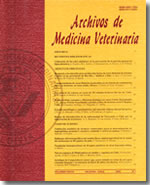Productive performance of F1 Pelibuey x Blackbelly lambs and crosses with Dorper and Katahdin in a production system in the humid tropic of Tabasco, México
Main Article Content
Abstract
The aim of this study was to evaluate the productive performance of F1 Pelibuey x Blackbelly (P x B) lambs and their crosses with Dorper and Katahdin (GM). Data on 648 birth weights (BW), preweaning daily weight gains (PGW1), adjusted weaning weights to 98 d (WWa), postweaning daily weight gains (PGW2), and postweaning sale weights adjusted to 198 days (PWs) were analyzed. The statistical model included the fixed effects of breeding group (P x B and GM), birth year (2000 to 2002), birth season (dry: February to April, rainy: May to October; and windy: November to January), birth type (single and multiples) and first-order interactions. The dam effect nested within genetic group was included as a random effect. Repeatability and partial correlations between traits were also calculated. Breeding group affected PGW1, WWa, PGW2 and PWs (P < 0.05). Year of birth affected PGW1, WWa and PGW2 (P < 0.01); season of birth affected all traits (P < 0.01) and type of birth affected BW, PGW1 and WWa (P < 0.01). The breeding group x year of birth and breeding group x season of birth interactions were significant for some traits. In conclusion, the P x B breeding group had a better performance than the GM group for most of the variables analised. Single lambs born during the dry season had the best performance.

